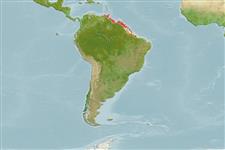Élasmobranches (requins et raies) (sharks and rays) >
Carcharhiniformes (Ground sharks) >
Carcharhinidae (Requiem sharks)
Etymology: Isogomphodon: iso-, from isos (Gr.), equal; gomphos (Gr.), nail; odon (Gr.), tooth, referring to how teeth are equally fastened, i.e., claviform and straight in both jaws. (See ETYFish); oxyrhynchus: oxys (Gr.), sharp; rhynchus (L.), snout, referring to its elongated, pointed and narrow snout [authorship often attributed to Müller & Henle, who published Valenciennes’ description]. (See ETYFish).
Environment: milieu / climate zone / depth range / distribution range
Écologie
marin; saumâtre démersal; profondeur ? - 15 m (Ref. 13608). Tropical; 12°N - 20°S, 63°W - 34°W (Ref. 244)
Western Atlantic: Trinidad, Guyana, Suriname, French Guiana, and Brazil.
Length at first maturity / Taille / Poids / Âge
Maturity: Lm 115.0 range ? - ? cm
Max length : 160 cm TL mâle / non sexé; (Ref. 34266); common length : 100.0 cm TL mâle / non sexé; (Ref. 5217); âge max. reporté: 12 années (Ref. 34266)
Large number of teeth, great length of very narrow snout. Yellow-gray above and white below (Ref. 6032).
An inshore shark found over rocky bottoms, entering estuaries and river mouths. Feeds on small schooling fishes including herring, anchovies and croakers. Viviparous, generally 4 embryos per brood; size at birth 38 to 41 cm. 244 cm record unconfirmed.
Distinct pairing with embrace (Ref. 205). Viviparous, placental (Ref. 50449).
Compagno, L.J.V., 1984. FAO Species Catalogue. Vol. 4. Sharks of the world. An annotated and illustrated catalogue of shark species known to date. Part 2 - Carcharhiniformes. FAO Fish. Synop. 125(4/2):251-655. Rome: FAO. (Ref. 244)
Statut dans la liste rouge de l'IUCN (Ref. 130435)
Utilisations par l'homme
Pêcheries: pêcheries vivrières
Plus d'informations
RéférencesAquacultureProfil d'aquacultureSouchesGénétiqueElectrophoresesHéritabilitéPathologiesTraitementNutrientsMass conversion
CollaborateursImagesStamps, Coins Misc.SonsCiguateraVitesseType de nageSurface branchialeOtolithesCerveauxVision
Outils
Articles particuliers
Télécharger en XML
Sources Internet
Estimates based on models
Preferred temperature (Ref.
123201): 27 - 27.8, mean 27.5 °C (based on 149 cells).
Phylogenetic diversity index (Ref.
82804): PD
50 = 1.0000 [Uniqueness, from 0.5 = low to 2.0 = high].
Bayesian length-weight: a=0.00468 (0.00218 - 0.01003), b=3.09 (2.92 - 3.26), in cm total length, based on LWR estimates for this (Sub)family-body shape (Ref.
93245).
Niveau trophique (Ref.
69278): 4.5 ±0.80 se; based on food items.
Generation time: 10.0 ( na - na) years. Estimated as median ln(3)/K based on 2
growth studies.
Résilience (Ref.
120179): Très faible, temps minimum de doublement de population supérieur à 14 ans (K=0.11-0.12; tm=5-7; tmax=12; Fec=4).
Fishing Vulnerability (Ref.
59153): High to very high vulnerability (74 of 100).
Nutrients (Ref.
124155): Calcium = 25.1 [3.3, 144.5] mg/100g; Iron = 0.725 [0.183, 2.103] mg/100g; Protein = 21.1 [18.8, 23.3] %; Omega3 = 0.16 [0.06, 0.40] g/100g; Selenium = 29.2 [7.9, 91.1] μg/100g; VitaminA = 18.4 [5.8, 57.1] μg/100g; Zinc = 0.728 [0.335, 1.386] mg/100g (wet weight);
